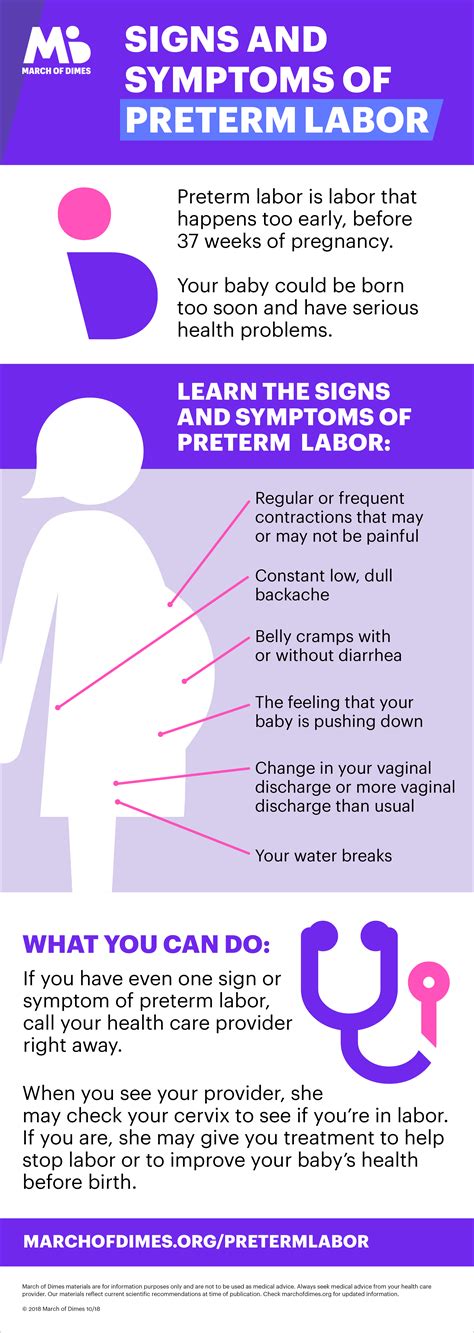Intro
Learn about preterm labor causes, symptoms, and treatment. Understand premature birth risks, signs, and prevention methods to ensure a healthy pregnancy and baby.
Preterm labor is a significant concern for pregnant women, as it can lead to premature birth and potentially serious health complications for the baby. It is essential to understand the signs, symptoms, and risk factors associated with preterm labor to ensure timely medical attention and optimal outcomes. Preterm labor can be a stressful and overwhelming experience, but with the right knowledge and support, women can navigate this challenging situation and make informed decisions about their care. The importance of preterm labor awareness cannot be overstated, as it can significantly impact the health and well-being of both the mother and the baby.
Preterm labor is a complex issue that affects many women worldwide, and its causes can be multifaceted. While some cases of preterm labor may be unavoidable, others can be prevented or managed with proper prenatal care and attention to risk factors. By understanding the underlying causes of preterm labor and taking proactive steps to mitigate them, women can reduce their risk of premature birth and ensure the best possible outcomes for their babies. Moreover, advances in medical technology and treatment options have improved significantly over the years, offering new hope and possibilities for women experiencing preterm labor.
The topic of preterm labor is multifaceted, and there is a lot to learn about its signs, symptoms, diagnosis, and treatment options. From the importance of prenatal care to the role of lifestyle factors in preventing preterm labor, there are many aspects to explore. By delving deeper into the world of preterm labor, women can gain a better understanding of their bodies and the factors that influence their pregnancy. This knowledge can empower them to make informed decisions about their care and take proactive steps to ensure a healthy and successful pregnancy.
What is Preterm Labor?

Risk Factors for Preterm Labor
Several risk factors can increase a woman's likelihood of experiencing preterm labor. These include: * A history of preterm birth * Multiple gestations (carrying twins or triplets) * Uterine or cervical abnormalities * Infections, such as urinary tract infections or group B strep * Chronic medical conditions, such as diabetes or high blood pressure * Lifestyle factors, such as smoking or substance abuse * Poor prenatal care or inadequate nutritionSigns and Symptoms of Preterm Labor

Diagnosis and Treatment of Preterm Labor
If a woman is experiencing symptoms of preterm labor, her healthcare provider will typically perform a physical examination and take a medical history to determine the cause of her symptoms. Diagnostic tests, such as ultrasound or fetal monitoring, may also be used to assess the baby's well-being and determine the best course of treatment. Treatment options for preterm labor may include: * Bed rest or hospitalization to reduce activity and stress on the body * Medications to stop or slow down contractions * Corticosteroids to promote fetal lung maturity * Antibiotics to treat any underlying infectionsPrevention of Preterm Labor

Lifestyle Factors and Preterm Labor
Lifestyle factors can play a significant role in the risk of preterm labor. Women who smoke or use illicit substances are at increased risk, as are those who are underweight or overweight. Poor nutrition and dehydration can also contribute to preterm labor, as can stress and anxiety. By making healthy lifestyle choices and taking proactive steps to manage stress and anxiety, women can reduce their risk of preterm labor and promote a healthy pregnancy.Complications of Preterm Labor

Support and Resources for Women Experiencing Preterm Labor
Women who are experiencing preterm labor may feel overwhelmed and anxious about their situation. It is essential to have a support system in place, including healthcare providers, family, and friends. Additional resources, such as counseling or support groups, may also be helpful in coping with the emotional and psychological aspects of preterm labor.Conclusion and Next Steps

We invite you to share your thoughts and experiences with preterm labor in the comments below. If you have any questions or concerns, please do not hesitate to reach out to your healthcare provider. Additionally, we encourage you to share this article with anyone who may be experiencing preterm labor or who is interested in learning more about this important topic.
What are the most common causes of preterm labor?
+The most common causes of preterm labor include a history of preterm birth, multiple gestations, uterine or cervical abnormalities, infections, and chronic medical conditions.
How can I reduce my risk of preterm labor?
+To reduce your risk of preterm labor, it is essential to receive regular prenatal care, avoid lifestyle factors that can increase your risk, eat a healthy and balanced diet, stay hydrated, and manage any chronic medical conditions.
What are the complications of preterm labor?
+The complications of preterm labor may include respiratory distress syndrome, infections, neurological problems, vision or hearing problems, and increased risk of stillbirth or infant mortality.
